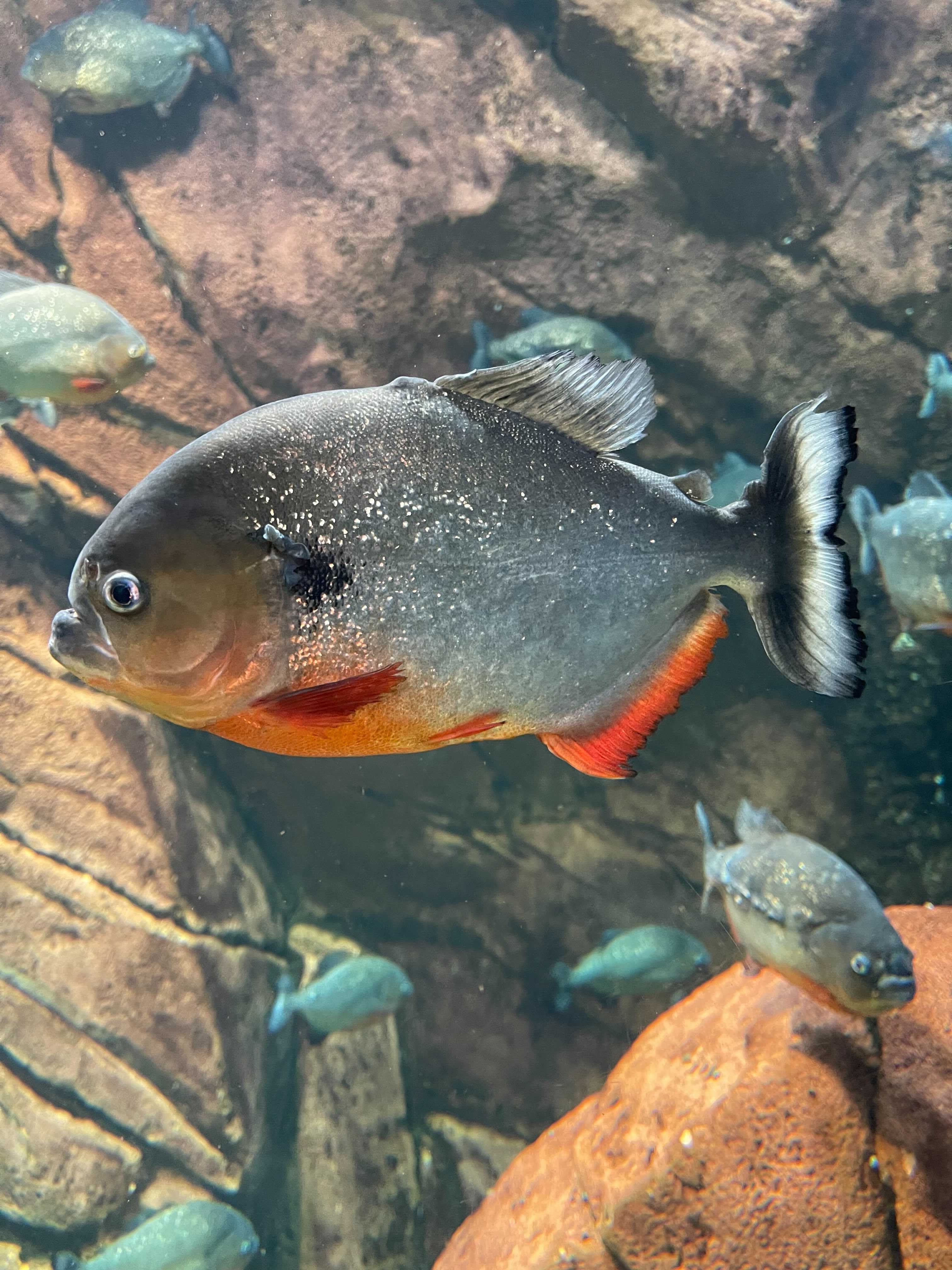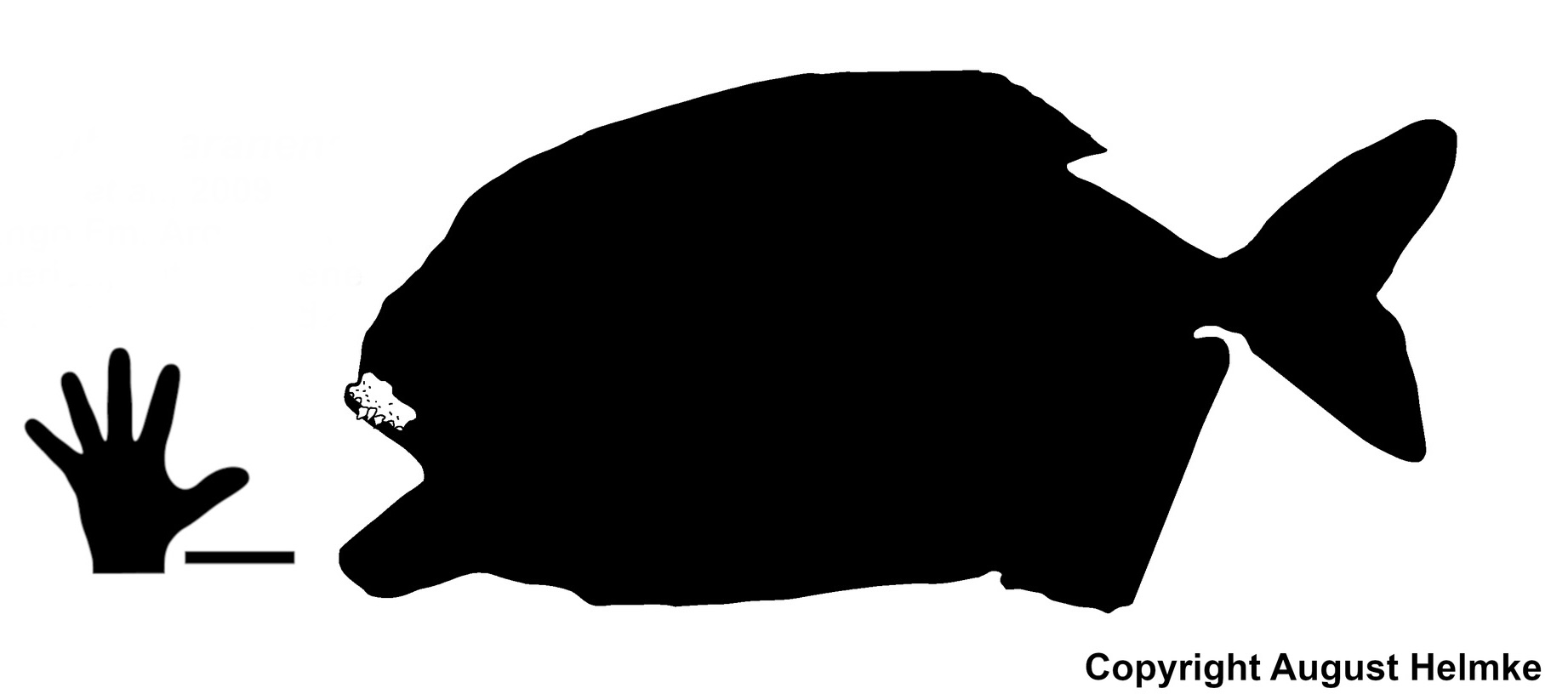|
Piranhas
A piranha or piraña (, , or ; or , ) is one of a number of freshwater fish in the family Serrasalmidae, or the subfamily Serrasalminae within the tetra family, Characidae in order Characiformes. These fish inhabit South American rivers, floodplains, lakes and reservoirs. Although often described as extremely predatory and mainly feeding on fish, their dietary habits vary extensively, and they will also take plant material, leading to their classification as omnivorous. Etymology The name originates from the indigenous Tupi people and their respective Tupi language. It is formed from two words, meaning fish and meaning tooth; the same word is used by Indians to describe a pair of scissors. Another possible derivation is from , probably literally "biting-fish". In the mid 18th century the Portuguese merged the word into . Finally, the word may also come from the combination of meaning fish and meaning cut (which also meant "bad" or "devil" in Tupi-Guarani). Taxonomy a ... [...More Info...] [...Related Items...] OR: [Wikipedia] [Google] [Baidu] |
Red-bellied Piranha
The red-bellied piranha, also known as the red piranha (''Pygocentrus nattereri''), is a Type (biology), type of piranha native to South America, found in the Amazon basin, Amazon, Paraguay River, Paraguay, Paraná River, Paraná and Essequibo River, Essequibo basins, as well as coastal rivers of northeastern Brazil.''Pygocentrus nattereri''. Animal Diversity Web. University of Michigan. Accessed 19 February 2016.Froese, R. and D. Pauly, Editors FishBase. 2015. This fish is locally abundant in its freshwater habitat. They are omnivorous foragers and feed on insects, worms, crustaceans, and fish. They are not a migratory species but do travel to seek o ... [...More Info...] [...Related Items...] OR: [Wikipedia] [Google] [Baidu] |
Megapiranha
''Megapiranha'' is an extinct serrasalmid characin fish from the Late Miocene (8–10 million years ago) Ituzaingó Formation of Argentina, described in 2009. The type species is ''M. paranensis''.''Megapiranha'' at Fossilworks.org It is thought to have been about in length and in weight. The consists only of e and a zigzag tooth row; the rest of its body is unknown. [...More Info...] [...Related Items...] OR: [Wikipedia] [Google] [Baidu] |
Serrasalmidae
The Serrasalmidae (serrasalmids) are a family of characiform fishes, recently elevated to family status. It includes more than 90 species. The name means "serrated salmon family", which refers to the serrated keel running along the belly of these fish. Fish classified as Serrasalmidae are also known by these common names: pacu, piranha, and silver dollar. These common names generally designate differing dental characteristics and feeding habits. Description Serrasalmids are medium- to large-sized characiform fishes that reach about long, generally characterized by a deep, laterally compressed body with a series of midventral abdominal spines or scutes, and a long dorsal fin (over 16 rays). Most species also possess an anteriorly directed spine just before the dorsal fin extending from a supraneural bone; exceptions include members of the genera ''Colossoma'', '' Piaractus'', and ''Mylossoma''. Most serrasalmids have about 60 chromosomes, ranging from 54 to 62.''Metynnis'' ... [...More Info...] [...Related Items...] OR: [Wikipedia] [Google] [Baidu] |
Serrasalminae
The Serrasalmidae (serrasalmids) are a family of characiform fishes, recently elevated to family status. It includes more than 90 species. The name means "serrated salmon family", which refers to the serrated keel running along the belly of these fish. Fish classified as Serrasalmidae are also known by these common names: pacu, piranha, and silver dollar. These common names generally designate differing dental characteristics and feeding habits. Description Serrasalmids are medium- to large-sized characiform fishes that reach about long, generally characterized by a deep, laterally compressed body with a series of midventral abdominal spines or scutes, and a long dorsal fin (over 16 rays). Most species also possess an anteriorly directed spine just before the dorsal fin extending from a supraneural bone; exceptions include members of the genera ''Colossoma'', '' Piaractus'', and '' Mylossoma''. Most serrasalmids have about 60 chromosomes, ranging from 54 to 62.''Metynnis'' ... [...More Info...] [...Related Items...] OR: [Wikipedia] [Google] [Baidu] |
Pygopristis
''Pygopristis denticulata'', or the Lobetoothed Piranha is a species of piranha. These fish are part of the group Ostariophysi, a large group of freshwater fish that includes minnows and catfishes. It is a rare South American fish found in the Orinoco River basin, north and eastern Guiana Shield rivers, and tributaries of the lower Amazon River. Piranhas typically live in freshwater, but other specimens can be found elsewhere. Specimens of this species is frequently found in acidic clear or black waters ''Black Waters'' is a 1929 British/American horror sound film produced by Herbert Wilcox and directed by Marshall Neilan. It was the first British-produced talking picture ever shown in England, but it was actually made in Hollywood since that i .... Piranhas are primarily known for being savage, flesh-eating fish, but they actually have broader diets. They usually feed on aquatic insects, small fish, and fruits.Machado-Allison, A. and W. Fink (1996). ''Los Peces Caribes de ... [...More Info...] [...Related Items...] OR: [Wikipedia] [Google] [Baidu] |
Serrasalmus
''Serrasalmus'' is a genus of piranhas. They are collectively known as pirambebas; the "typical" piranhas like the piraya piranha are nowadays placed in '' Pygocentrus''. Like all piranhas, ''Serrasalmus'' are native to South America. These fish are predatory, have sharp teeth and generally have a rhomboid shape. In some, the shape is more ovoid, particularly in old specimens. Some ''Serrasalmus'' species can exceed (''S. manueli'' and ''S. rhombeus'', according to OPEFE), placing them among the largest Serrasalmidae. Species There are at least 31 recognized species in this genus: * '' Serrasalmus altispinis'' Merckx, Jégu & dos Santos, 2000 * '' Serrasalmus altuvei'' Ramírez, 1965 (''caribe pinche'') * '' Serrasalmus auriventris'' ( Burmeister, 1861) * '' Serrasalmus brandtii'' Lütken, 1875 (white piranha) * '' Serrasalmus compressus'' Jégu, Leão & dos Santos, 1991 * '' Serrasalmus eigenmanni'' Norman, 1929 * '' Serrasalmus elongatus'' Kner, 1858 (slender pira ... [...More Info...] [...Related Items...] OR: [Wikipedia] [Google] [Baidu] |
Pristobrycon
''Pristobrycon'' is a genus of piranhas from the Orinoco and Amazon Basins, as well as rivers in the Guianas. ''Pristobrycon'' is not monophyletic. No single morphological feature has been found that completely diagnoses this genus. ''P. striolatus'' is very different from other species of this genus. The genus ''Pristobrycon'' was created by Eigenmann to include species which have intermediate characters between "the fierce ''Rooseveltiella'' ''Pygocentrus nattereri''">Pygocentrus_nattereri.html" ;"title="''Pygocentrus nattereri">''Pygocentrus nattereri''without palatine teeth, and the less blood-thirsty ''Serrasalmus'' with a series of permanent teeth along the palatine". The author designed ''P. calmoni'' as the type species of the genus. Two groups are included in this genus. One group is characterized by presence of the preanal spine (only ''P. calmoni'') and the other group including the rest of the species assigned (''P. careospinus'', ''P. maculipinnis'' and ''P. striol ... [...More Info...] [...Related Items...] OR: [Wikipedia] [Google] [Baidu] |
Pacu
Pacu () is a common name used to refer to several species of omnivorous South American freshwater serrasalmid fish that are related to the piranha. Pacu and piranha do not have similar teeth, the main difference being jaw alignment; piranha have pointed, razor-sharp teeth in a pronounced underbite, whereas pacu have squarer, straighter teeth and a less severe underbite, or a slight overbite. Pacu, unlike piranha, mainly feed on plant material and not flesh or scales. Additionally, the pacu can reach much larger sizes than piranha, at up to in total length and in weight. Name The common name ''pacu'' is generally applied to fish classified under the below listed genera. Among these, several genera contain species where commonly used English names include the word ''pacu'', as listed. *''Colossoma'' – black pacu, black-finned pacu, giant pacu *''Metynnis'' *''Mylesinus'' (''Myloplus'') *''Mylossoma '' *''Ossubtus'' – parrot pacu, eaglebeak pacu *'' Piaractus'' – red-bel ... [...More Info...] [...Related Items...] OR: [Wikipedia] [Google] [Baidu] |
Paraguay River
The Paraguay River (Río Paraguay in Spanish, Rio Paraguai in Portuguese, Ysyry Paraguái in Guarani) is a major river in south-central South America, running through Brazil, Bolivia, Paraguay and Argentina. It flows about from its headwaters in the Brazilian state of Mato Grosso to its confluence with the Paraná River north of Corrientes and Resistencia. Course The Paraguay's source is south of Diamantino in the Mato Grosso state of Brazil. It follows a generally southwesterly course, passing through the Brazilian city of Cáceres. It then turns in a generally southward direction, flowing through the Pantanal wetlands, the city of Corumbá, then running close to the Brazil-Bolivia border for a short distance in the Brazilian states of Mato Grosso and Mato Grosso do Sul. From the city of Puerto Bahia Negra, Paraguay, the river forms the border between Paraguay and Brazil, flowing almost due south before the confluence with the Apa River. The Paraguay makes a long, gen ... [...More Info...] [...Related Items...] OR: [Wikipedia] [Google] [Baidu] |
Guianas
The Guianas, sometimes called by the Spanish loan-word ''Guayanas'' (''Las Guayanas''), is a region in north-eastern South America which includes the following three territories: * French Guiana, an overseas department and region of France * Guyana, formerly known as British Guiana from 1831 until 1966, after the colonies of Berbice, Essequibo, and Demerara, taken from the Netherlands in 1814, were merged into a single colony * Suriname, formerly Dutch Guiana, until 1814 together with Berbice, Essequibo and Demerara In the wider context, the Guianas also includes the following two territories: * Guayana Region in eastern Venezuela ( Amazonas, Bolívar, and Delta Amacuro states), formerly the Guayana Province, alternatively known as Spanish Guayana * State of Amapá in northern Brazil, known as Portuguese Guiana (or Brazilian Guiana) History Pre-colonial period Before the arrival of European colonials, the Guianas were populated by scattered bands of native Arawak peo ... [...More Info...] [...Related Items...] OR: [Wikipedia] [Google] [Baidu] |
Family (biology)
Family ( la, familia, plural ') is one of the eight major hierarchical taxonomic ranks in Linnaean taxonomy. It is classified between order and genus. A family may be divided into subfamilies, which are intermediate ranks between the ranks of family and genus. The official family names are Latin in origin; however, popular names are often used: for example, walnut trees and hickory trees belong to the family Juglandaceae, but that family is commonly referred to as the "walnut family". What belongs to a family—or if a described family should be recognized at all—are proposed and determined by practicing taxonomists. There are no hard rules for describing or recognizing a family, but in plants, they can be characterized on the basis of both vegetative and reproductive features of plant species. Taxonomists often take different positions about descriptions, and there may be no broad consensus across the scientific community for some time. The publishing of new data and opin ... [...More Info...] [...Related Items...] OR: [Wikipedia] [Google] [Baidu] |
Paraná River
The Paraná River ( es, Río Paraná, links=no , pt, Rio Paraná, gn, Ysyry Parana) is a river in south-central South America, running through Brazil, Paraguay, and Argentina for some ."Parana River". Encyclopædia Britannica. Encyclopædia Britannica Online. Encyclopædia Britannica Inc., 2012. Web. 26 May. 2012 . "Rio de la Plata". Encyclopædia Britannica. Encyclopædia Britannica Online. Encyclopædia Britannica Inc., 2012. Web. 26 May. 2012 Among South American rivers, it is second in length only to the Amazon River. It merges with the Paraguay River and then farther downstream with the Uruguay River to form the Río de la Plata and empties into the Atlantic Ocean. The first European to go up the Paraná River was the Venetian explorer Sebastian Cabot, in 1526, while working for Spain. A drought hit the river in 2021, causing a 77-year low. Etymology In eastern South America there is "an immense number of river names containing the element ''para-'' or ''parana-''", ... [...More Info...] [...Related Items...] OR: [Wikipedia] [Google] [Baidu] |




